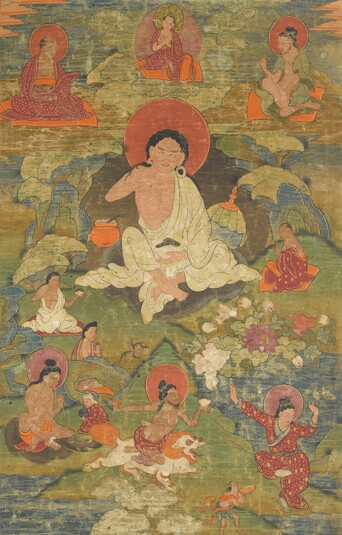
Item: Teacher (Lama) - Milarepa
| Origin Location | Tibet |
|---|---|
| Date Range | 1700 - 1799 |
| Lineages | Gelug and Buddhist |
| Material | Ground Mineral Pigment on Cotton |
| Collection | Private |
Milarepa: the great poet yogi of Tibet accompanied by six siddhas, according to the Vajrasana System of the Eighty-four Mahasiddhas, in the surrounding landscape of the composition. The painting belongs to a much larger composition of an unknown number of paintings with only one other painting from the set identified - a Je Tsongkapa as a Mahasiddha. This means that all five of the special forms of Tsongkapa would be represented as central figures in this Mahasiddha Painting Set. It also means that we know of six central figure identifications for this set. There are six mahasiddhas per composition which works out to a painting set of fifteen paintings.
 Mi la re pa
Mi la re pa  Biographical Details
Biographical Details
At the top center is Arya Nagarjuna. At the bottom center riding a lion is Simhapa. At the bottom left side is Luipa.
The painting set was commissioned by a follower of the Gelug tradition as is evidenced by the Five Forms of Tsongkapa made obvious by the Tsongkapa as a mahasiddha riding the tiger. The style of painting is Eastern Tibetan with mixed elements of New Menri and Kham-dri. The shading on the rock outcroppings with the blue, green and light brown is very reminiscent of Lhatog (Khampa Gar) style. The region where the paintings were made is very likely to be in Kham on the west side of the river opposite Dege and somewhere between the major Gelug centers of Dragyab and Chamdo.
Jeff Watt 1-2016
Teacher: Milarepa (Lineage Paintings)
Teacher: Milarepa Main Page
Collection: Private 1
Tradition: Kagyu Founding Teachers
Subject: Guruyoga Iconography Page
Collection: Bonhams New York (Painting. March 14, 2016)
Painting Set: Eighty-four Mahasiddhas (Milarepa & Tsongkapa)


